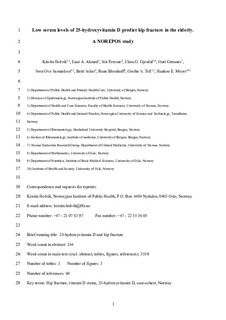Low Serum Levels of 25-Hydroxyvitamin D Predict Hip Fracture in the Elderly: A NOREPOS Study
Holvik, Kristin; Ahmed, Luai Awad; Forsmo, Siri; Gjesdal, Clara Gram; Grimnes, Guri; Samuelsen, Sven Ove; Schei, Berit; Blomhoff, Rune; Tell, Grethe S; Meyer, Haakon E
Original version
Journal of Clinical Endocrinology and Metabolism. 2013, 98 (8), 3341-3350. 10.1210/jc.2013-1468Abstract
Background: Despite considerable interest, the relationship between circulating 25-hydroxyvitamin D and the risk of hip fracture is not fully established. Objective: The objective of the study was to study the association between serum 25-hydroxyvitamin D concentrations [s-25(OH)D] and the risk of hip fracture in Norway, a high-latitude country that has some of the highest hip fracture rates worldwide. Methods: A total of 21 774 men and women aged 65–79 years attended 4 community-based health studies during 1994–2001. Information on subsequent hip fractures was retrieved from electronic hospital discharge registers, with a maximum follow-up of 10.7 years. Using a stratified case-cohort design, s-25(OH)D was determined by HPLC-atmospheric pressure chemical ionization-mass spectrometry in stored serum samples in hip fracture cases (n = 1175; 307 men, 868 women) and in gender-stratified random samples (n = 1438). Cox proportional hazards regression adapted for the case-cohort design was performed. Results: We observed an inverse association between s-25(OH)D and hip fracture; those with s-25(OH)D in the lowest quartile (<42.2 nmol/L) had a 38% [95% confidence interval (CI) 9–74%] increased risk of hip fracture compared with the highest quartile (≥67.9 nmol/L) in a model accounting for age, gender, study center, and body mass index. The association was stronger in men than in women: hazard ratio 1.65 (95% CI 1.04–2.61) vs hazard ratio 1.25 (95% CI 0.95–1.65). Conclusion: In this prospective case-cohort study of hip fractures, the largest ever reported, we found an increased risk of hip fracture in subjects in the lowest compared with the highest quartile of serum 25-hydroxyvitamin D. In accordance with the findings of previous community-based studies, low vitamin D status was a modest risk factor for hip fracture.
